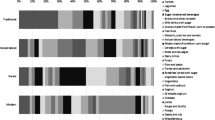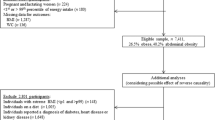Abstract
Background/Objectives:
Food portion sizes have been increasing in industrialized countries and this is thought to be one of the risk factors of overweight. France is also facing the development of adiposity, particularly in its child population, where overweight rates are rising faster than in adults. Given this background, the objectives of the present study were, for each food category, to describe dietary intake in French children aged 3–11 years, and to assess the relationship between childhood overweight and portion size, adjusting for dietary energy density, physical activity and sedentary behaviour.
Subjects/Methods:
A representative sample of 748 French children aged 3–11 years was taken from the 1998–1999 cross-sectional French INCA1 (Enquête Individuelle et Nationale sur les Consommations Alimentaires) food consumption survey. Dietary intake was assessed using a 7-day food record. Portion sizes were estimated for 23 food categories. Weight and height, physical activity and sedentary behaviour were reported by parents or children in questionnaires.
Results:
In multivariate logistic regression adjusted models, overweight in children aged 3–6 years was positively correlated to portion sizes of croissant-like pastries and other sweetened pastries. Conversely, portion sizes of liquid dairy products were inversely associated with overweight in children aged 7–11 years.
Conclusions:
At very young ages, the increase in overweight may be driven in part by a shift in eating patterns towards larger portion size of energy-dense and nutrient-poor foods.
This is a preview of subscription content, access via your institution
Access options
Subscribe to this journal
Receive 12 print issues and online access
$259.00 per year
only $21.58 per issue
Buy this article
- Purchase on Springer Link
- Instant access to full article PDF
Prices may be subject to local taxes which are calculated during checkout
Similar content being viewed by others
References
Bandini LG, Schoeller DA, Cyr HN, Dietz WH (1990). Validity of reported energy intake in obese and nonobese adolescents. Am J Clin Nutr 52, 421–425.
Bell AC, Kremer PJ, Magarey AM, Swinburn BA (2005). Contribution of ‘noncore’ foods and beverages to the energy intake and weight status of Australian children. Eur J Clin Nutr 59, 639–645.
Birch LL, Fisher JO (1998). Development of eating behaviors among children and adolescents. Pediatrics 101, 539–549.
Borrud L, Enns CW, Mickle S (1997). What we eat: USDA surveys food consumption changes. Commun Nutr Inst 27, 4–5.
Brener ND, McManus T, Galuska DA, Lowry R, Wechsler H (2003). Reliability and validity of self-reported height and weight among high school students. J Adolesc Health 32, 281–287.
Cole TJ, Bellizzi MC, Flegal KM, Dietz WH (2000). Establishing a standard definition for child overweight and obesity worldwide: international survey. Br Med J 320, 1240–1243.
Deheeger M, Rolland-Cachera MF, Fontvieille AM (1997). Physical activity and body composition in 10 year old French children: linkages with nutritional intake? Int J Obes Relat Metab Disord 21, 372–379.
Diliberti N, Bordi PL, Conklin MT, Roe LS, Rolls BJ (2004). Increased portion size leads to increased energy intake in a restaurant meal. Obes Res 12, 562–568.
Ello-Martin JA, Ledikwe JH, Rolls BJ (2005). The influence of food portion size and energy density on energy intake: implications for weight management. Am J Clin Nutr 82, 236S–241S.
Favier JC, Ireland J, Toque C, Feinberg M (1995). Répertoire Général Des Aliments. Tec et Doc: Paris.
Fontvieille AM, Kriska A, Ravussin E (1993). Decreased physical activity in Pima Indian compared with Caucasian children. Int J Obes Relat Metab Disord 17, 445–452.
Foster E, Matthews JNS, Nelson M, Harris JM, Mathers JC, Adamson AJ (2006). Accuracy of estimates of food portion size using food photographs—the importance of using age-appropriate tool. Public Health Nutr 9, 509–514.
Guthrie JF, Lin BH, Frazao E (2002). Role of food prepared away from home in the American diet, 1977–1978 versus 1994–1996: changes and consequences. J Nutr Educ Behav 34, 140–150.
Hercberg S, Deheeger M, Preziosi P (1994). SU-VI-MAX. Portions Alimentaires. Manuel Photos Pour L'estimation Des Quantités. Poly Technica: Paris.
Huang TT, McCrory MA (2005). Dairy intake, obesity, and metabolic health in children and adolescents: knowledge and gaps. Nutr Rev 63, 71–80.
Huang TT, Howarth NC, Lin BH, Roberts SB, McCrory MA (2004). Energy intake and meal portions: associations with BMI percentile in US children. Obes Res 12, 1875–1885.
Jahns L, Siega-Riz AM, Popkin BM (2001). The increasing prevalence of snacking among US children from 1977 to 1996. J Pediatr 138, 493–498.
Kral TV (2006). Effects on hunger and satiety, perceived portion size and pleasantness of taste of varying the portion size of foods: a brief review of selected studies. Appetite 46, 103–105.
Kral TV, Rolls BJ (2004). Energy density and portion size: their independent and combined effects on energy intake. Physiol Behav 82, 131–138.
Kriska AM, Knowler WC, LaPorte RE, Drash AL, Wing RR, Blair SN et al. (1990). Development of questionnaire to examine relationship of physical activity and diabetes in Pima Indians. Diabetes Care 13, 401–411.
Labeyrie C, Niel X (2004). La santé des enfants scolarisés en CM2 à travers les enquêtes de santé scolaire en 2001–2002. Drees Etudes et Résultats no. 313 Dress: Paris.
Ledikwe JH, Blanck HM, Kettel Khan L, Serdula MK, Seymour JD, Tohill BC et al. (2006). Dietary energy density is associated with energy intake and weight status in US adults. Am J Clin Nutr 83, 1362–1368.
Ledikwe JH, Ello-Martin JA, Rolls BJ (2005). Portion sizes and the obesity epidemic. J Nutr 135, 905–909.
Lillegaard ITL, Overby NC, Andersen LF (2005). Can children and adolescents use photographs of food to estimate portion sizes? Eur J Clin Nutr 59, 611–617.
Lioret S, Maire B, Volatier JL, Charles MA (2007). Child overweight in France and its relationship with physical activity, sedentary behaviour and socio-economic status. Eur J Clin Nutr 61, 509–516.
Livingstone MBE, Robson PJ (2000). Measurement of dietary intake in children. Proc Nutr Soc 59, 279–293.
McConahy KL, Smiciklas-Wright H, Birch LL, Mitchell DC, Picciano MF (2002). Food portions are positively related to energy intake and body weight in early childhood. J Pediatr 140, 340–347.
McConahy KL, Smiciklas-Wright H, Mitchell DC, Picciano MF (2004). Portion size of common foods predicts energy intake among preschool-aged children. J Am Diet Assoc 104, 975–979.
Nicklaus S, Boggio V, Chabanet C, Issanchou S (2005). A prospective study of food variety seeking in childhood, adolescence and early adult life. Appetite 44, 289–297.
Nielsen SJ, Popkin BM (2003). Patterns and trends in food portion sizes, 1977–1998. JAMA 289, 450–453.
Nielsen SJ, Siega-Riz AM, Popkin BM (2002). Trends in energy intake in US between 1977 and 1996: similar shifts seen across age groups. Obes Res 10, 370–378.
Orlet Fisher J, Rolls BJ, Birch LL (2003). Children's bite size and intake of an entree are greater with large portions than with age-appropriate or self-selected portions. Am J Clin Nutr 77, 1164–1170.
Platat C, Perrin AE, Oujaa M, Wagner A, Haan MC, Schlienger JL et al. (2006). Diet and physical activity profiles in French preadolescents. Br J Nutr 96, 501–507.
Putmann JJ, Allshouse JE (1999). Food Consumption, Prices, and Expenditures, 1970–1997. Food and Consumers Economics Division, Economic Research Service, US Department of Agriculture: Washington, DC.
Rennie KL, Jebb SA, Wright A, Coward WA (2005). Secular trends in under-reporting in young people. Br J Nutr 93, 241–247.
Rolland-Cachera MF, Castetbon K, Arnault N, Bellisle F, Romano MC, Lehingue year et al. (2002). Body mass index in 7–9-y-old French children: frequency of obesity, overweight and thinness. Int J Obes Relat Metab Disord 26, 1610–1616.
Rolls BJ, Engell D, Birch LL (2000). Serving portion size influences 5-year-old but not 3-year-old children's food intakes. J Am Diet Assoc 100, 232–234.
Rolls BJ, Morris EL, Roe LS (2002). Portion size of food affects energy intake in normal-weight and overweight men and women. Am J Clin Nutr 76, 1207–1213.
Rolls BJ, Roe LS, Meengs JS (2006a). Larger portion sizes lead to a sustained increase in energy intake over 2 days. J Am Diet Assoc 106, 543–549.
Rolls BJ, Roe LS, Meengs JS (2006b). Reductions in portion size and energy density of foods are additive and lead to sustained decreases in energy intake. Am J Clin Nutr 83, 11–17.
Shah NP (2000). Effects of milk-derived bioactives: an overview. Br J Nutr 84, S3–S10.
Strauss RS (1999). Comparison of measured and self-reported weight and height in a cross-sectional sample of young adolescents. Int J Obes Relat Metab Disord 23, 904–908.
Volatier JL (2000). Enquête INCA Individuelle Et Nationale Sur Les Consommations Alimentaires. Tec et Doc: Paris.
Young LR, Nestle M (2002). The contribution of expanding portion sizes to the US obesity epidemic. Am J Public Health 92, 246–249.
Young LR, Nestle M (2003). Expanding portion sizes in the US marketplace: implications for nutrition counseling. J Am Diet Assoc 103, 231–234.
Zemel MB, Miller SL (2004). Dietary calcium and dairy modulation of adiposity and obesity risk. Nutr Rev 62, 125–131.
Zizza C, Siega-Riz AM, Popkin BM (2001). Significant increase in young adults' snacking between 1977–1978 and 1994–1996 represents a cause for concern!. Prev Med 32, 303–310.
Author information
Authors and Affiliations
Corresponding author
Additional information
Contributors: SL designed the study, analysed and interpreted the data and wrote the manuscript. BM contributed to the conceptualization of the study, interpretation of the results, and editing of the manuscript. J-LV contributed to the design of the survey and the data collection, and together with LL and MT, supervised the analysis and helped to write the paper.
Rights and permissions
About this article
Cite this article
Lioret, S., Volatier, JL., Lafay, L. et al. Is food portion size a risk factor of childhood overweight?. Eur J Clin Nutr 63, 382–391 (2009). https://doi.org/10.1038/sj.ejcn.1602958
Received:
Revised:
Accepted:
Published:
Issue Date:
DOI: https://doi.org/10.1038/sj.ejcn.1602958
Keywords
This article is cited by
-
Dietary energy density and obesity: how consumption patterns differ by body weight status
European Journal of Nutrition (2018)



